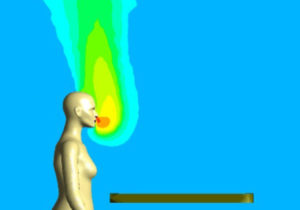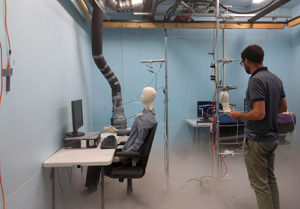An expected benefit of the Internet of Things (IoT) in buildings will come from an improved ability to monitor indoor environments in ways that lead to actionable insights. A panel session hosted by UC Berkeley’s Center for the Built Environment (CBE) explored three innovative methods to monitor buildings using the latest in sensing and communicating technologies. The ideas range from futuristic to immediately applicable, with a focus on measuring CO2. Understanding CO2 concentrations in buildings is important, as several recent studies suggest that high levels of the gas may have negative effects on our cognitive performance, yet there are challenges to measuring it in a reliable and comprehensive manner.
IEQ Bot: An autonomous mobile robot system for measuring indoor environments
A challenge to creating highly-granular monitoring of buildings is the cost of installing and maintaining numerous sensors throughout a building. Berkeley PhD candidate Ming Jin has addressed this through his development of an autonomous robot, which he has named the IEQ Bot. This robot can navigate and map a building interior, and measure indoor environmental quality (IEQ) with a wireless sensing platform. However, data collected in this manner is sparse in terms of both time and space, and must be interpolated using advanced algorithms to represent IEQ trends. Therefore the IEQ Bot has been programmed with powerful data analytics to assess the measurements it collects as it moves through a building. The video featured above shows the device, the view from the “robot cam,” and a visualization of its mapping software, as it navigates a building.
In laboratory studies, Ming demonstrated that the IEQ Bot’s analytics system accurately estimated gas concentrations throughout a building compared to measurements from a set of fixed and densely configured sensors. These results indicate that this approach may provide good sensing capability with a minimal sensor cost and calibration efforts.
Such a robot could be used to monitor a wide range of metrics: thermal comfort, lighting, air quality, acoustics, and pollutant source identification. It may also provide a unique method for building commissioning and post-occupancy evaluation. Ming Jin’s work was funded by SinBerBEST, with oversight from Prof. Costas Spanos and Assoc. Prof. Stefano Schiavon, and assistance of postdoctoral scholar Shichao Liu. A paper on this work is online here (subscription required).
Using wearable sensors to measure personal exposure to CO2
The current best practice for monitoring CO2 is with wall mounted sensors. However, because building occupants are source of CO2, the concentration can vary considerably within a space, and has been shown to be significantly higher immediately around occupants, or in the “inhalation zone.” During the panel session, CBE Researcher Jovan Pantelic presented new work that investigated the potential benefits from using wearable sensors to monitor the gas.

Simulation of CO2 shows higher concentration around the body.
For the study, human subjects were seated at a desk, in some cases with computers or table fans, in CBE’s test chamber with an ambient CO2 concentration of 520 parts per million. (For comparison, normal outdoor air is 350-400 ppm, and the ASHRAE limit for indoor concentration is 700 ppm above the background level.) Using CO2 monitors worn like amulets around test subjects’ necks, the test showed that concentrations immediately around the subjects were 500 to 620 ppm higher than the ambient room conditions. However, with desk fans this was reduced greatly as the airflow disrupts the “thermal plumes” around the subjects bodies.
The next steps for the project team include looking into productivity improvements with the use of ceiling and desk fans, and scaling up this study for a field demonstration. This study was funded by the U.S. General Services Administration, with in-kind support from Aclima, a member of CBE’s industry consortium. Contributors included Brian Gilligan of GSA, and Nicole Goebel, Melissa Lunden and Scott Andrews of Aclima Inc. A paper on this work is in development.
Optimal placement of CO2 sensors for a displacement ventilation system
Displacement ventilation (DV) systems supply air at a low level and with low velocity into a space, creating vertical gradients of both temperature and CO2. Displacement ventilation systems may be favored in spaces with high occupancy and no other strong pollutant sources, such as classrooms and conference rooms, or for energy efficiency.

Smoke visualization was used in the displacement ventilation study.
In normal practice, both temperature and CO2 sensors are mounted at head height, with no concern to the horizontal location, as it has been assumed that the vertical gradients would be similar throughout the room. However, as demonstrated by laboratory studies by PhD candidate Matt Vannucci, the CO2 concentration in fact is highly variable horizontally within a space. Building occupants, of course, are not distributed evenly in a space, and CO2 does not quickly mix horizontally. Based on this study, the new recommendation for the design of DV buildings will be to locate sensors at a high level or at the air exhaust grille.
The next step for this work will be to develop a correction for the ceiling level sensors to accurately estimate occupant exposure. The results of this work will be published to inform future guidelines for DV systems (ASHRAE 62.1), and will be included in a doctoral dissertation. This work was funded by CBE with in-kind support from Price Industries. The project team included Fred Bauman, Paul Raftery, Stefano Schiavon of CBE, and Mike Koupriyanov of Price Industries.
These three projects showcase how CBE’s research team is developing new technologies for monitoring and improving indoor environments, work we are leading in collaboration with CBE’s industry partners. The panel was part of CBE’s Industry Advisory Board Meeting, which took place on October 26, 2017, on the UC Berkeley campus.
The video featured above was created by Ming Jin, a UC Berkeley PhD candidate in Electrical Engineering and Computer Science.
